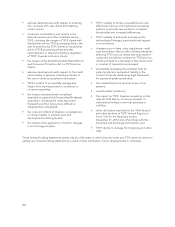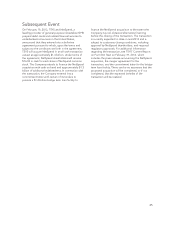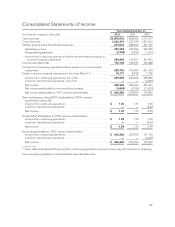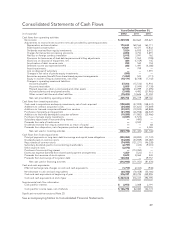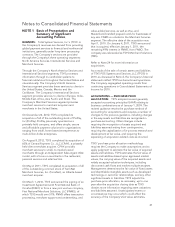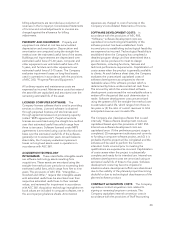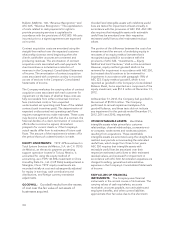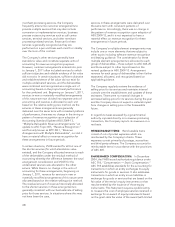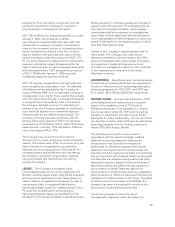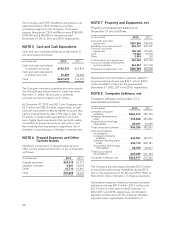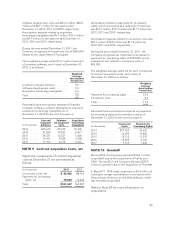NetSpend 2012 Annual Report Download - page 37
Download and view the complete annual report
Please find page 37 of the 2012 NetSpend annual report below. You can navigate through the pages in the report by either clicking on the pages listed below, or by using the keyword search tool below to find specific information within the annual report.Bulletin (SAB) No. 104, “Revenue Recognition” and
ASC 605, “Revenue Recognition.” The capitalization
of costs related to cash payments for rights to
provide processing services is capitalized in
accordance with the provisions of ASC 605. All costs
incurred prior to a signed agreement are expensed
as incurred.
Contract acquisition costs are amortized using the
straight-line method over the expected customer
relationship (contract term) beginning when the
client’s cardholder accounts are converted and
producing revenues. The amortization of contract
acquisition costs associated with cash payments for
client incentives is included as a reduction of
revenues in the Company’s Consolidated Statements
of Income. The amortization of contract acquisition
costs associated with conversion activity is recorded
as cost of services in the Company’s Consolidated
Statements of Income.
The Company evaluates the carrying value of contract
acquisition costs associated with each customer for
impairment on the basis of whether these costs are
fully recoverable from either contractual minimum
fees (contractual costs) or from expected
undiscounted net operating cash flows of the related
contract (cash incentives paid). The determination of
expected undiscounted net operating cash flows
requires management to make estimates. These costs
may become impaired with the loss of a contract, the
financial decline of a client, termination of conversion
efforts after a contract is signed, diminished
prospects for current clients or if the Company’s
actual results differ from its estimates of future cash
flows. The amount of the impairment is written off in
the period that such a determination is made.
EQUITY INVESTMENTS: TSYS’ 49% investment in
Total System Services de México, S.A. de C.V. (TSYS
de México), an electronic payment processing
support operation located in Toluca, Mexico, is
accounted for using the equity method of
accounting, as is TSYS’ 44.56% investment in China
UnionPay Data Co., Ltd. (CUP Data) headquartered in
Shanghai, China. TSYS’ equity investments are
recorded initially at cost and subsequently adjusted
for equity in earnings, cash contributions and
distributions, and foreign currency translation
adjustments.
GOODWILL: Goodwill results from the excess
of cost over the fair value of net assets of
businesses acquired.
Goodwill and intangible assets with indefinite useful
lives are tested for impairment at least annually in
accordance with the provisions of ASC 350. ASC 350
also requires that intangible assets with estimable
useful lives be amortized over their respective
estimated useful lives to their estimated residual
values.
The portion of the difference between the cost of an
investment and the amount of underlying equity in
net assets of an equity method investee that is
recognized as goodwill in accordance with the
provisions of ASC 323, “Investments — Equity
Method and Joint Ventures,” shall not be amortized.
However, equity method goodwill shall not be
reviewed for impairment in accordance with ASC 350,
but instead should continue to be reviewed for
impairment in accordance with paragraph 19(h) of
ASC 323. Equity method goodwill, which is not
reported as goodwill in the Company’s Consolidated
Balance Sheet, but is reported as a component of the
equity investment, was $51.3 million at December 31,
2012.
At December 31, 2012, the Company had goodwill in
the amount of $518.3 million. The Company
performed its annual impairment analyses of its
goodwill balance, and these tests did not indicate
any impairment for the periods ended December 31,
2012, 2011 and 2010, respectively.
OTHER INTANGIBLE ASSETS: Identifiable
intangible assets relate primarily to customer
relationships, channel relationships, covenants-not-
to-compete, trade names and trade associations
resulting from acquisitions. These identifiable
intangible assets are amortized using the straight-line
method over periods not exceeding the estimated
useful lives, which range from three to ten years.
ASC 350 requires that intangible assets with
estimable useful lives be amortized over their
respective estimated useful lives to their estimated
residual values, and reviewed for impairment in
accordance with ASC 360. Amortization expenses are
charged to selling, general and administrative
expenses in the Company’s Consolidated Statements
of Income.
FAIR VALUES OF FINANCIAL
INSTRUMENTS: The Company uses financial
instruments in the normal course of its business. The
carrying values of cash equivalents, accounts
receivable, accounts payable, accrued salaries and
employee benefits, and other current liabilities
approximate their fair value due to the short-term
34


